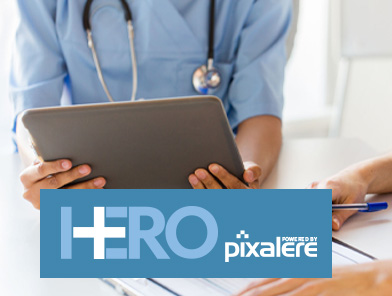VHA Home HealthCare (VHA) – a leading Ontario-based homecare organization – has partnered with Pixalere Healthcare Inc. (pixalere.com), pioneers in wound management clinical software, to successfully co-develop a comprehensive, clinically focused home & community-based EMR.
Building on a partnership that started in 2013, the two organizations have since collaborated on expanding the application beyond wound care. “We wanted to have the agility to create a system to suit their needs and modernize their workflow,” said Ken Hendsbee, CEO, Pixalere.
Named EMRI (Electronic Medical Records Initiative) by VHA, it’s a fully customizable cloud-based system designed by clinicians for clinicians. It contains a full suite of clinical forms, assessments, and digital reports allowing care providers to document
effectively on the go.
EMRI is now being re-branded by Pixalere under the name HERO (Homecare Electronic Record Outcomes). Although designed initially for Ontario clinicians, HERO can be effectively used by homecare providers in any Canadian province.
The clinical data collected in the system can be securely shared with their partners and clients through standards-based APIs. Most recently VHA has become the first homecare provider to make their clinical data accessible through Sunnybrook’s MyChart patient portal. “We’re pleased to be at the digital forefront of health system integration for the benefit of our clients and families,” said Alistair Forsyth, CIO, VHA Home HealthCare. The “built-for-Ontario” solution can perform audits, track and electronically document everything
that happened during a client-provider encounter. “We’ve gone from a paper-based system to documenting in real-time, and client files will never be lost or misplaced,” Forsyth added.
When asked how the system is being used in the field, VHA’s professional practice specialist – clinical informatics, and registered nurse, Kartini Mistry, said the Pixalere wound-care system’s design was expanded to meet a broader range of complex client needs, which encompasses nursing and rehabilitation clients. “Clinically, it’s being used to support VHA’s holistic approach to care which may include head-to-toe assessments, medication management, acute and chronic diseases, wound care, home dialysis, children with complex medical needs, as well as rehabilitation clients requiring home exercise programs and assistive device planning.”
She added, “With our remote workforce, this is a single solution that captures the full end-to-end documentation of client-provider interactions.
“Clinicians can access the right information whenever it’s needed, and not just for client information, but also clinical decision support tools and education which promotes best practice and better outcomes.” This includes access to a client’s past documentation for better continuity of care. “It lets us see a client’s full history in real-time, bridging the practice gap,” said Mistry. HERO also provides point-of-care decision support, built-in clinical forms with real-time alerts, and it improves efficiency by streamlining documentation.
VHA says its EMR for homecare is being used by about 90 percent of its clinicians.
Pixalere and VHA have created peer-to-peer user groups that meet on a regular basis. They discuss what parts of the system are working well, and areas to improve as well as sharing new enhancements collected from their providers and other stakeholders. “We’re constantly learning,” said Kathy McKenna, manager of health information management at VHA. “The usergroup meetings provide us with real-time feedback, allowing us to make changes quickly.”
HERO is used by nurses, PSWs, physiotherapists and occupational therapists, and adapts to how each clinician works. It also integrates with other community based clinical information systems such as GoldCare and Procura.
Regarding their future plans, McKenna said they’ll be expanding to include dietetics, social work and speech language pathology documentation, and data integration with client portals and analytics. “And we’re just getting started.”
To learn more about HERO, visit www.hero.pixalere.com.

